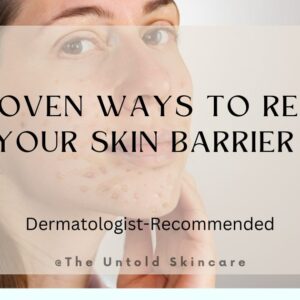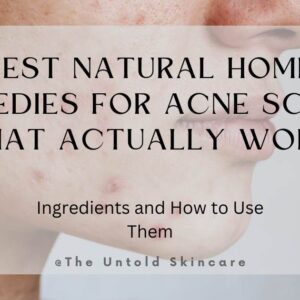Acnes are an unwelcome surprise no matter where they appear on your body.
While they are commonly associated with the face, the chest is another region where this skin condition can manifest.
Chest acne occurs on the chest area, including the upper chest and sometimes extending to the shoulders and back. It tends to form in areas with a high density of hair follicles and oil glands.
But what causes these red bumps to appear on your chest?
Well, there are a lot of potential factors that can contribute to it.
So, let’s dive in and uncover the truth behind those stubborn chest pimples, and discover the strategies and remedies that can help you achieve a clearer and smoother chest complexion.
How is Chest Acne Different From Face Acne?
Chest acne and face acne share similarities, as both are forms of acne caused by clogged hair follicles and the overproduction of oil. In simpler terms, chest acne is the same as face acne, just located at a different location.
Both chest and face acne can present in various forms, including whiteheads, blackheads, small red bumps called papules, inflamed bumps like pustules, and even large deep-seated bumps.
One distinguishing distinction between the two is that, while face acne may also itch, it usually doesn’t itch as badly as chest acne.
Additionally, the skin on the chest is a bit thicker than the skin on the face, so you can use slightly more strong products to treat it.
What Causes Chest Acne?
The chest, composed of numerous hair follicles, oil glands, and sweat glands, is a prime location for acne to emerge.
Just like facial acne, chest acne occurs when these hair follicles become obstructed with a combination of sebum (skin oil), dead skin cells, and bacteria.
When it comes to dealing with chest pimples, it’s crucial to understand the underlying causes that may be lurking beneath the surface. Let’s discuss them in detail:
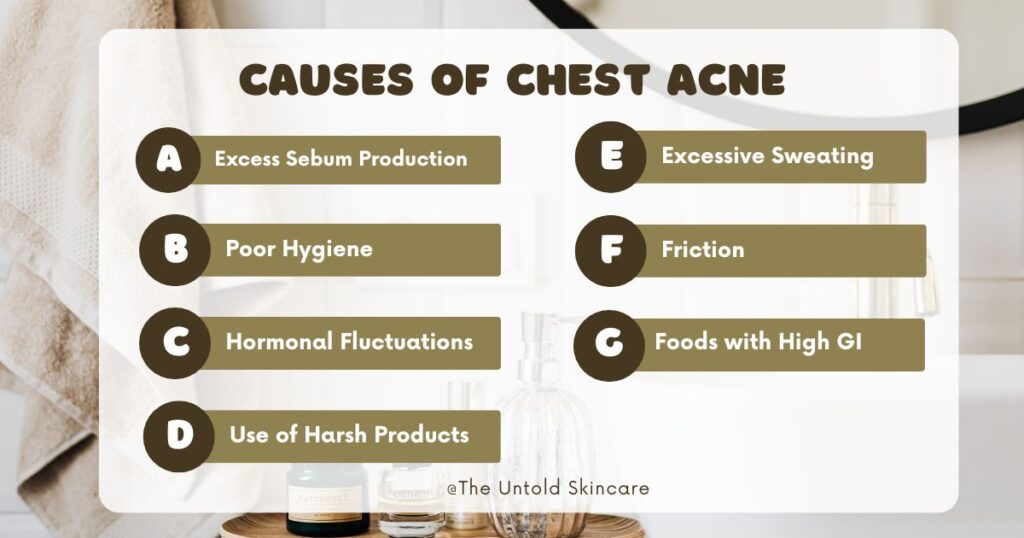
Excess Sebum Production
One common culprit behind chest pimples is excessive oil production.
The sebaceous glands, which are responsible for producing oil, can become overactive and clog pores, leading to the formation of pimples. This can be exacerbated by sweat, especially if you engage in activities that cause you to sweat heavily.
Poor Hygiene
Poor hygiene practices can also play a role in the appearance of pimples on the chest.
Failing to cleanse the skin properly or neglecting to remove sweaty clothing promptly can lead to the accumulation of dirt, sweat, and bacteria in the chest area. This provides an ideal environment for acne-causing bacteria to thrive and cause breakouts.
Foods with High Glycemic Index
High glycemic index foods are one of the major causes of almost every skin issue.
Foods with a high GI value are quickly broken down into sugar which raises the blood sugar level. In order to lower the blood sugar level, our body releases a specific hormone called insulin. Insulin tries to bring down the sugar level by delivering it to body cells.
High insulin levels boost the skin’s production of sebum. Additionally, because the bacteria feed on sugar, the sugar found in skin cells draws more of these germs to the surface. All of these are directly related to acne.
Hormonal Fluctuations
Hormonal imbalances can often be the hidden culprit behind those red bumps that pop up on your chest.
Both men and women have testosterone, but it is typically more prevalent in males. When testosterone levels increase, it can stimulate the sebaceous glands in our skin to produce more oil.
In women, hormonal changes particularly during puberty, menstruation, pregnancy, and menopause, can trigger an increase in sebum production.
This excess oil can combine with dead skin cells and bacteria, leading to clogged follicles and acne breakouts on the chest.
Use of Harsh Products
Harsh products can strip the skin of its natural oils. While excess oil can contribute to acne, completely stripping the skin of its oils can lead to a rebound effect where the skin responds by producing even more oil to compensate.
Also, they can disrupt the protective skin barrier and cause physical irritation to the skin. They can also remove all friendly bacteria from the skin making it more prone to acne and break-outs.
Excessive Sweating
Our chests are susceptible to sweat accumulation, especially during intense physical activities or hot weather conditions. As sweat mixes with bacteria and dead skin cells, it can clog the pores on the chest, leading to the formation of pesky pimples.
Friction
Another hidden cause of chest pimples is friction.
Tight-fitting clothing, such as sportswear or tight shirts, can rub against the skin and create friction. This constant rubbing, combined with sweat, can irritate the hair follicles and pores, causing breakouts.
Additionally, constant friction between the fabric and the skin can result in irritation and inflammation, further encouraging the chest skin to break out.
How to get rid of chest acne?
Now is the time to discuss why you are actually here.
The chest area requires similar attention and care as our face. Let’s discuss some of the highly effective ways to get rid of chest acne:
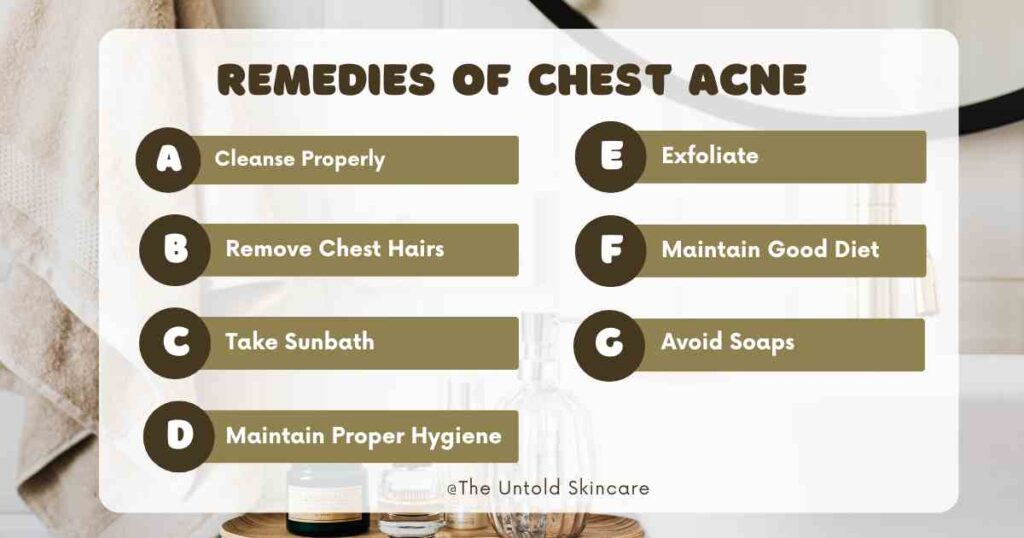
Cleanse Properly
The most important thing is to have a proper cleanse of chest area on a regular basis. Just like we cleanse and moisturize our face, we should extend these steps to our chest as well.
Along with the face, chest is another part of our body that has the most active oil glands. The accumulation of oil along with dead skin cells and bacteria on the chest can clog the skin pores and cause breakouts.
Additionally, the condition can be made worse by the sweat that the body produces when it mixes with oil and dead skin cells. So, it is extremely crucial to cleanse the chest area regularly.
Use a mild, non-comedogenic cleanser that is specifically formulated for acne-prone skin.
I highly recommend you to look for a cleanser that has Benzoyl peroxide in it as it is clinically proven to kill acne-causing bacteria. You can also use salicylic acid cleaner as it can easily penetrate into your skin pores and clean deeply.
Gently wash your chest with lukewarm water and the cleanser, making sure to remove any dirt, sweat, and excess oil that may have accumulated throughout the day. Avoid scrubbing aggressively, as this can irritate the skin and potentially worsen the condition.
Remove Chest Hairs
Removing your chest hair is actually a great way to cure your chest acne. It is also a well-researched remedy as well.
The hair is capable of drawing moisture from the skin making it dry and itchy. It can trap sweat, dirt, and bacteria against the skin, leading to clogged pores and increased risk of infection.
Some research has shown that hair can hinder proper air circulation to the skin, creating a warm and humid environment in which bacteria thrive. Removing the hair allows the skin to breathe better, discouraging bacterial growth.
These hair rubbing against the skin can increase irritation which can further worsen the acne. It can also be an obstruction for the skin so by removing it, you can have easy access to the skin to clean and treat it properly.
Take Morning Sunbath

Avoiding sun exposure is a well-known mantra in skincare, but if done correctly, it can be quite beneficial to the skin.
Bacterial overgrowth can hugely contribute to acne development on any part of the body. Sunlight has antimicrobial properties that can help reduce the growth of bacteria on the skin. It can even kill certain acne-causing bacteria.
The vitamin D present in sunlight plays a crucial role in skin health and immune function. Adequate vitamin D levels may help regulate the skin’s immune response and reduce inflammation associated with acne.
About 20 minutes of morning sun will do the job for you. However, stay out of the sun during midday.
Exfoliate
Proper exfoliation is crucial for maintaining a healthy and clear chest. It can help reduce chest acne by removing dead skin cells, unclogging pores, and promoting smoother, clearer skin.
Exfoliation also speeds up the natural process of cell turnover, where new skin cells are produced and rise to the surface. It also allows other products to be absorbed more effectively.
Use a gentle exfoliator or a soft body brush to remove dead skin cells and unclog pores. Be mindful not to over-exfoliate, as this can irritate the skin and worsen breakouts.
Aim to exfoliate 1-2 times a week to keep your chest smooth and prevent bumps formation.
Salicylic acid can be a perfect exfoliator when it comes to exfoliating chest skin. It can penetrate deeply into the pores and help dissolve dead skin cells and excess oil.
Avoid using physical scrubs as they can further irritate the skin.
Avoid Using Soaps and Harsh Products
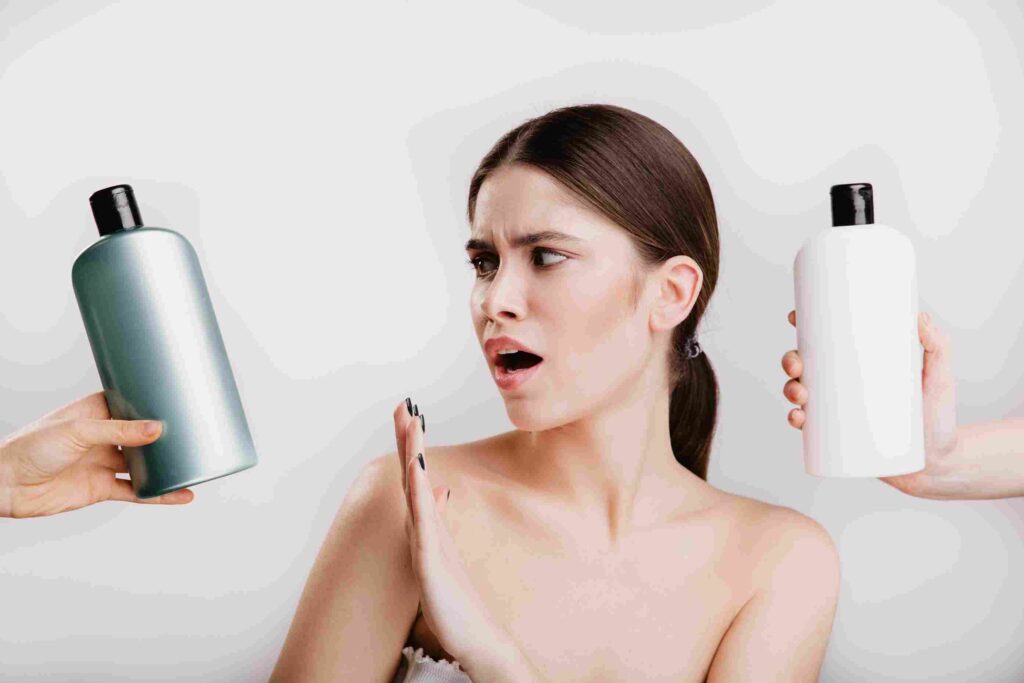
If you have chest acne, using soap can be one of the worst mistakes. Many conventional soaps are harsh and can strip the skin of its natural oils.
The additives and fragrances added to soaps can cause skin irritation and excessive dryness. Acne-prone chest skin is more likely to be sensitive and harsh soaps can further aggravate this sensitivity, causing redness, itching, and discomfort.
Always look for products that are gentle and specifically formulated to treat acne-prone skin. Look for labels that indicate the absence of harsh chemicals such as sulfates, parabens, and synthetic fragrances.
Maintain Proper Hygiene
Maintaining good hygiene practices is crucial when it comes to preventing and treating pimples on your chest. By incorporating a few simple hygiene practices into your daily routine, you can significantly reduce the occurrence of those itchy bumps.
Develop the habit of having a shower regularly and never wear dirty or sweaty clothes. Do not wear the same dress for more than 2-3 days without washing it.
Take Care of Your Diet
Maintaining a balanced and healthy diet can contribute to improved skin health and may help reduce the occurrence of acne breakouts.
Foods rich in omega-3 fatty acids are extremely beneficial for skin health. Opt for foods such as fatty fish, chia seeds, flax seeds, and walnuts.
Berries, nuts, seeds, and green tea are examples of foods rich in antioxidants that can help protect your skin from oxidative stress.
Similarly, foods rich in probiotics, such as yogurt, sauerkraut, and kimchi, can promote a healthy gut microbiome, which may have a positive impact on skin health.
Try to avoid foods containing sugar or high carbohydrate as they have high glycemic index. Also avoid greasy and fried foods and reduce dairy consumption. Add more fruits and veggies to your diet as their nutritional content is extremely high.
Also Read: 10 Much-Needed Lifestyle Changes for Clear Skin
Best Home Remedies for Chest Acne
Some natural and home remedies can be effective in controlling and preventing chest acne.
One widely used natural remedy is tea tree oil. Known for its antibacterial properties, tea tree oil can help reduce inflammation and kill acne-causing bacteria. Simply dilute a few drops of tea tree oil with a carrier oil, such as coconut oil, and apply it to the affected area using a cotton pad or swab.
Another remedy is to use diluted Apple Cider Vinegar. ACV is a rich source of probiotics that helps in balancing the skin microbiome. It is also highly capable of balancing the pH of the skin. Spread the diluted ACV thoroughly on cleaned skin and leave it for 10-15 minutes. Then rinse it off with lukewarm water.
Another effective home remedy for chest acne is the paste of honey, lemon and turmeric. Lemon is not usually recommended for face acne but it is quite safe to use to treat chest acne since the chest skin is much thicker than face acne.
The lemon present in it can kill acne-causing bacteria whereas honey helps in soothing the skin. Similarly, turmeric can greatly reduce skin inflammation. The mixture of these three can greatly benefit chest acne.
Simply mix half lemon juice with one tsp honey and half tsp turmeric. You can also add little yogurt for extra benefits. Spread the mixture on affected areas and leave it for 20 minutes. They gently rinse it off with lukewarm water.
Medications for Chest Acne
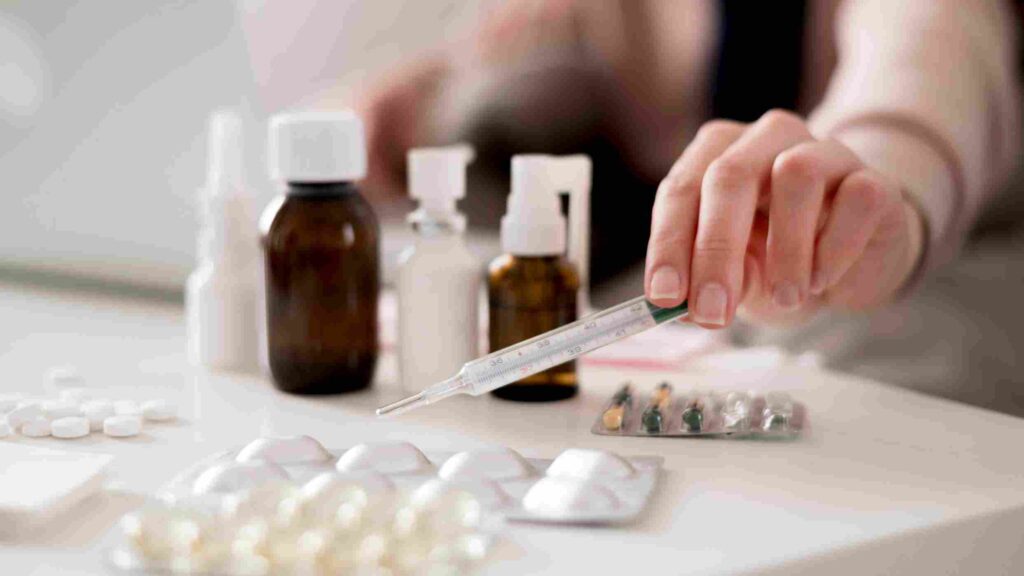
There are several medications available, both over-the-counter and prescription based, that can be effective in treating chest acne. The choice of medication depends on the severity of the acne and individual factors.
One of the most common ingredients found in over-the-counter topical treatments for any acne is benzoyl peroxide.
This powerful ingredient works by killing bacteria on the skin’s surface and unclogging pores. It also helps to reduce excess oil production, which is often a contributing factor to chest acne.
Salicylic acid is another popular ingredient found in many acne treatments. This beta-hydroxy acid helps to exfoliate the skin, removing dead cells and unclogging pores. By promoting cell turnover, salicylic acid helps to prevent new breakouts from forming.
Similarly, prescription retinoids like tretinoin and adapalene work by unclogging pores, reducing inflammation and promoting skin cell turnover.
Similarly, topical antibiotics like clindamycin or erythromycin can help control acne-causing bacteria and reduce inflammation.
If your chest acne is persistent and is not responding to any other treatment, you can try prescription-based Accutane. It significantly reduces oil production and can have long-lasting effects.
Also Read: 5 Best Skincare Ingredients of All Time
When to Seek a Professional’s Help?
Since the causes are many, a comprehensive evaluation by an expert allows them to identify potential triggers or contributing factors that may be exacerbating your condition.
If the acne is persistent, the itching is severe, and causing you pain, do not hesitate to schedule an appointment with a dermatologist. Their professional advice and expertise can help unmask the hidden causes of your pimples and set you on the path to clearer, healthier skin.


